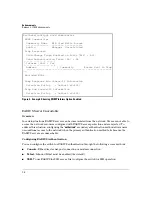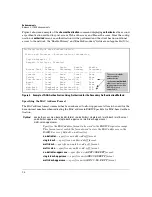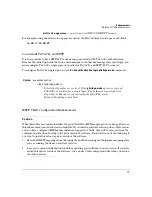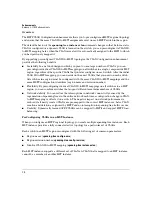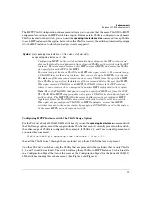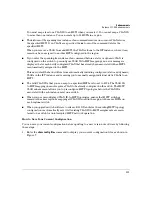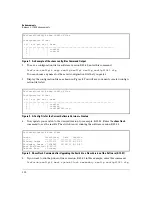
103
Enhancements
Release L.11.08 Enhancements
After rebooting, the switch is running software version K.12.43 and is using the configuration file
that you saved for this software version, configK1243.cfg.
You can also save the K.12.43 configuration file on a TFTP server. If you wanted to reload the K.12.43
version of the software again, reload the configuration file before you do the reload.
Rebooting and Reloading the Switch
The switch offers reboot options through the
boot
and
reload
commands, plus the options inherent
in a dual-flash image system. Generally, using
boot
provides more comprehensive self-testing; using
reload
gives you a faster reboot time.
Rebooting from the Current Software Version. Reload
reboots the switch from the flash image
and startup-config file on which the switch is currently running, and provides the option for saving
to the startup-config file any configuration changes currently in the running-config file. Because
reload
bypasses some subsystem self-tests, the switch reboots faster than if you use either of the
boot
command options.
Syntax:
reload
For example, if you change the number of VLANs the switch supports, you must reboot the switch
in order to implement the change. Reload automatically saves your configuration changes and
reboots the switch from the same software image you have been using:
Scheduled Reload.
Beginning with software release K.11.34, additional parameters have been added
to the reload command to allow for a scheduled reboot of the switch via the CLI.
Syntax:
reload [after <[dd:]hh:]mm> | at <hh:mm[:ss]> [<mm/dd[/[yy]yy]]>] | cancel]
Enables a scheduled warm reboot of the switch. Parameters include:
•
after
: Schedules a warm reboot of the switch after a given
amount of time has passed.
•
at
: Schedules a warm reboot of the switch at a given time.
•
cancel
: Removes a pending reboot request.
The scheduled reload feature supports the following capabilities:
■
It removes the requirement to physically reboot the switch at inconvenient times (for
example, at 1:00 in the morning). Instead, a
reload at 1:00
mm/dd
command can be executed
(where
mm/dd
is the date the switch is scheduled to reboot).
■
It provides a safety net in situations where a change is made from a remote location to the
running config that inadvertently causes loss of management access. For example, a newly
configured ACL might deny access to the switch from the management station’s IP address
such that the telnet session ceases to function. Scheduling a
reload after
command (timed






